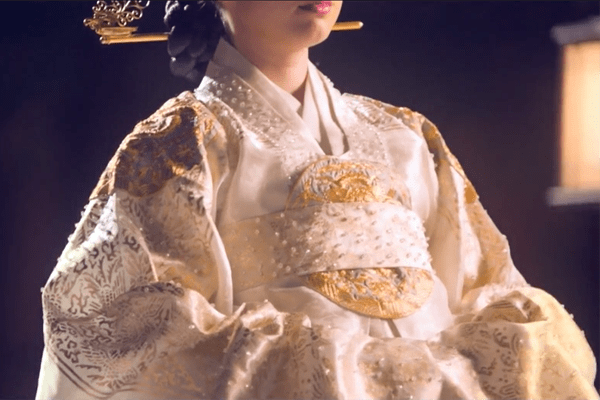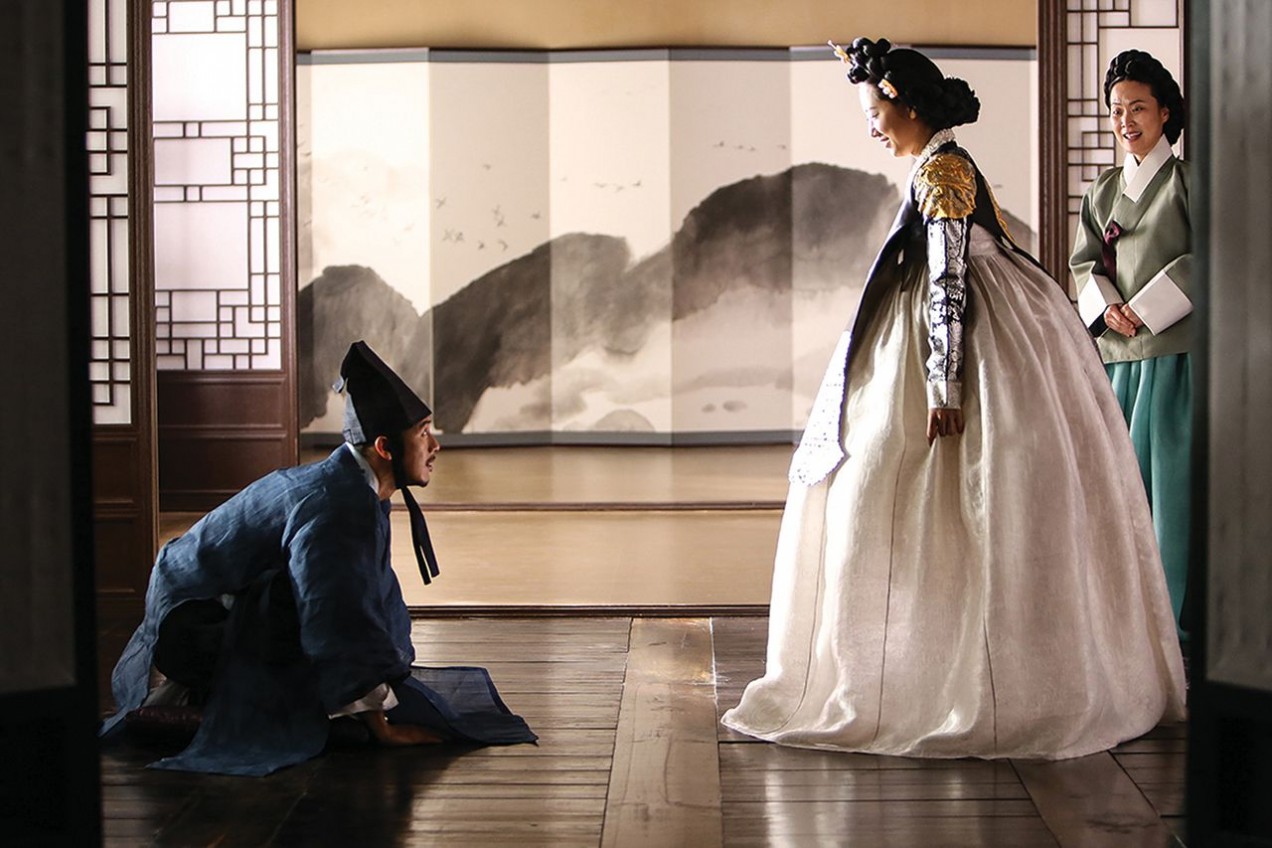Director Lee Won-suk’s second feature was released in 2014, a year after his black comedy How to Use Guys with Secret Tips. He confessed that he wasn’t a fan of sageuk (historical drama) and the soundtrack by Mowg reflects that ambivalence: it’s a playful mash-up, Variety wrote, of “70s jive with Western chamber music,” and was one reason the reception for the film was mixed. Throughout the film Lee Won-Suk is willing to embrace anachronisms, not only in music—appealing to fans of Sofia Coppola’s Marie Antoinette (2006), maybe, rather than those who prefer some attempt at historical accuracy. (The period in question is the reign of King Yeonglo, spanning three-quarters of the eighteenth century.) There’s also a short fantasy sequence that disrupts the film’s historic narrative—see more on this below. (Korean audiences, Lee Won-suk says, “hated” the giant-bunnies-on-the-moon moment.)
Lee Won-Suk was drawn to the story because of its focus on fashion: the costume budget for the film was vast, managed by costume designer Cho Sang-kyung. (It’s not a surprise that she’s also worked on the TV series It’s Okay To Not Be Okay and films The Handmaiden and The Fortress.)

This was the first Korean movie I saw, some years ago on an international flight. The flight ended before the film did. I was confused by the tone, which veered from broad comedy to melodrama to tragedy: it was part Shakespeare in Love and part A Royal Affair, and hard to read. Five years later, much more is familiar about the film, including that range of tones, as well as the look of Joseon-era narrow streets and thatched houses, and the exuberant swell of the hanbok.

Unusually for sageuk, the film has contemporary book-ends. A press conference announces the discovery of a dress from the Joseon era, recently returned from an overseas collection, made by the man who revolutionized Joseon fashion—Head Tailor Cho Dol-Suk. By the time the film ends, with that dress on display behind glass, we’ve learned, of course, that there’s much more to this story of intrigue and innovation. It’s a tale of two tailors, and the corrupting force of jealousy, both personal and professional. The historical story is visually bookended in another way, through white—the colour of mourning at the beginning of the film, and of the light snow that falls at the end, metaphor for a different kind of sadness. Between these stark poles is a riot of rich colour and texture, the film’s chief strength: its cinematographer is Kim Ji-Yong whose credits include The Fortress and Hwayi: A Monster Boy.
Some of the tropes here are familiar: the king refuses to sleep with his beautiful young wife—see Empress Ki, 100 Days My Prince, Moon Embracing the Sun—so has no heir: his ministers want him to replace the queen. The royal estrangement isn’t for the usual reasons of an imposed political match, but for deeper issues around a wounded ego. The young king, sullen and aggrieved, is played by Yoo Yeon-Sok (of Reply 1994, Dr Romantic and Mr. Sunshine). He spends most of his time shooting arrows and being bitter. The son of a concubine, he’s never felt good enough. “Nothing in this palace was ever mine,” he rants. Later in the film we’ll learn precisely why he’s so indifferent to the Queen. In fact, we’ll be told three times over: once when the character Pan-soo (Ma Dong-seok of Train to Busan) tells us; once in a flashback scene that reveals the reason via metaphor; and once when the king himself explains it, in case it’s still not clear.
Disquiet over status and entitlement informs the king’s bad humour, and it’s also the secret rot devouring the head tailor, Cho Dol-seok. Actor Han Suk-kyu’s career pre-dates the Korean Wave: he’s been a film star since the mid 90s, though audiences new to the landscape might know him best for the 2019 sageuk film Forbidden Dream (directed by Heo Jin-ho of The Last Princess) or both seasons of the TV series Dr Romantic. As head of the Sanguiwon, the department in charge of royal attire, Dol-seok has an austere authority and surface calm that belies his ambition. Like the king, he’s felt slighted; in flashback we see him sold as child, forbidden to write, stumbling to his career because he had good hands for sewing— a woman’s job, as a drunk nobleman tells him. Dol-seok has aspirations to the nobility himself, and this desire for status makes him both conservative at the Sanguiwon (clothes reflect status and must adhere to rules) and cutthroat with possible competition.

This competition takes the form of rakish young tailor Lee Gong-jin (Go Soo of The Last Princess and The Fortress), always in trouble with the ladies and their outraged parents. He’s portrayed as a contemporary artist: in his studio in the kisaeng (courtesan) compound, white paper doll shapes dangle, and ink sketches are pinned to the walls, near a woman’s form made from straw. Gong-jin brands a bracken leaf design into all his clothes and gets his skirt-shape inspiration from maids cleaning giant pots. He’s all instinct and inspiration, while Dol-seok prides himself—to a fault—on skill and tradition. Gong-jin, he says, is just a “lowlife who makes cheap dresses.”

They share a grudging admiration, but in the king-needs-an-heir fight they back different women. Gong-jin is smitten with the young queen at first sight, through she’s always obscured behind a gauzy screen and only seamstresses are permitted to measure her. Dol-seok makes a gown for an interloper, the Defence minister’s daughter who has her eye on the throne. When the king starts seeking out Gong-jin’s work, and the women in town wear his new fasions, Dol-seok feels usurped and under threat. The intense rivalry between love interests, political interests and tailors twists through the film—taking in bonfires, theft, slashing, sexual tension, beatings and accusations— and wrings tragedy from the final scenes.
The dramatic storyline is enlivened or undermined, depending on your point of view, by the broad comedy around Gong-jin. His clothes are so appealing that the king wants to sleep with every woman in court: we see the king tumbling onto a mat with each new lover as the doors slam, men ogling women in their new dresses, face-slapping among the women of the court.
Gong-jin’s daydreams include cartoonish flowers and trees, cranes and butterflies, and clouds shaping into giant white rabbits pounding a mortar—interludes that proved unpopular, as the director noted. There’s much of beauty in The Royal Tailor, and strong performances by the rival designers, in particular, even if the story components don’t quite cohere, and both the silliness and the melodrama work against narrative depth.
